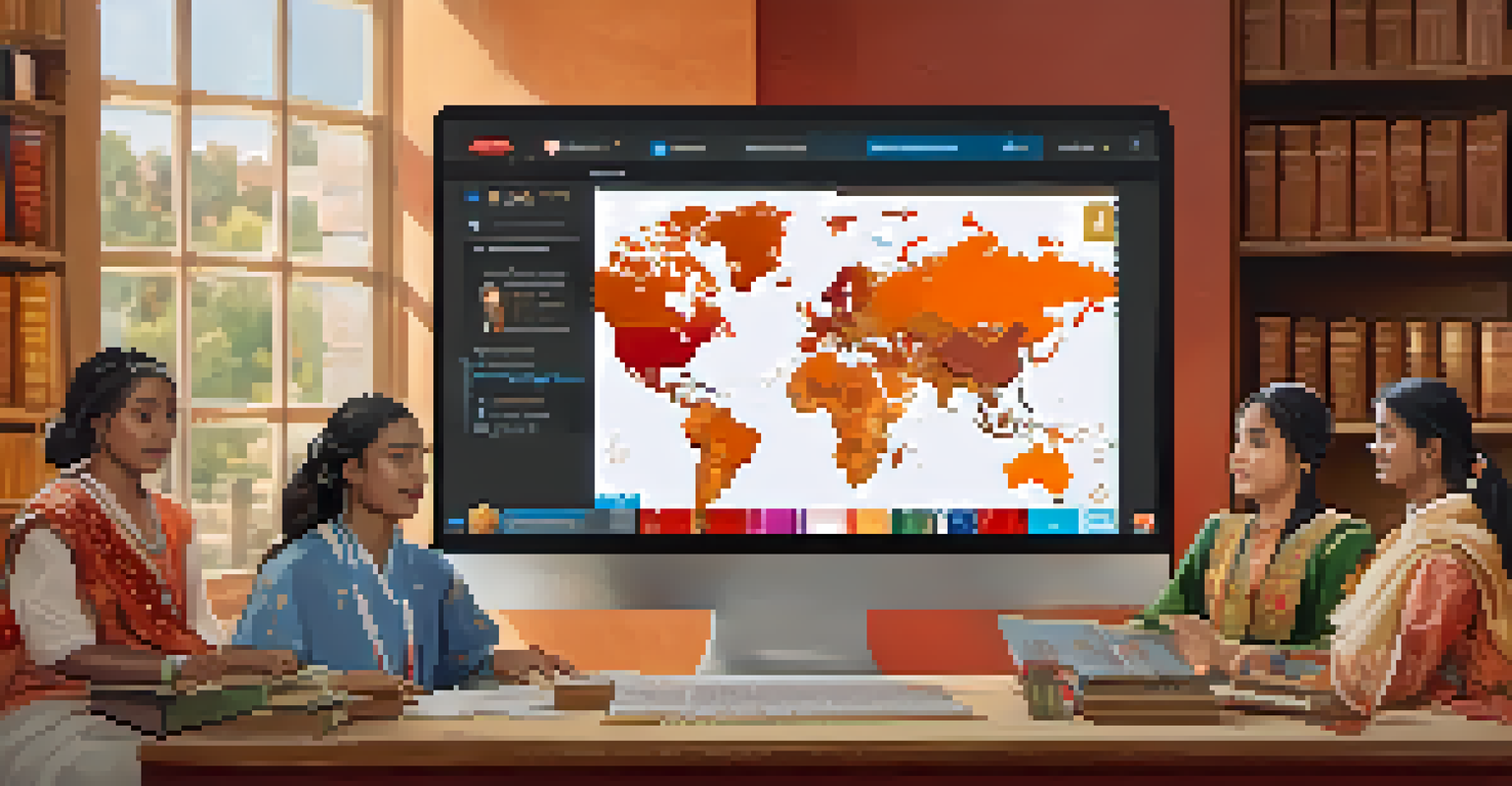India’s Educational Initiatives for Cultural Exchange

Introduction to India's Cultural Exchange Initiatives
India has long been a melting pot of cultures, and its educational initiatives reflect this diversity. With a focus on fostering understanding and appreciation of different cultures, these programs aim to build bridges between students from various backgrounds. By integrating cultural exchange into education, India is not only enriching its students' knowledge but also promoting global citizenship.
Culture is the widening of the mind and of the spirit.
These initiatives often involve partnerships with foreign universities and institutions, allowing for a vibrant exchange of ideas and perspectives. This collaborative approach enables students to experience different cultures firsthand, paving the way for mutual respect and understanding. As the world becomes more interconnected, such initiatives are crucial for nurturing a generation that values diversity.
In addition, India’s rich history and traditions serve as a foundation for these educational programs. By incorporating cultural elements into the curriculum, students gain a deeper appreciation of their own heritage while learning about others. This two-way exchange fosters an environment where cultural dialogue thrives.
Key Programs Promoting Cultural Exchange
Several programs play pivotal roles in promoting cultural exchange within the Indian education system. Initiatives like the 'Study in India' program encourage international students to experience Indian culture while pursuing their studies. This program not only introduces foreign students to Indian traditions but also allows local students to engage with diverse perspectives.

Another notable initiative is the 'Cultural Exchange Program' offered by the Ministry of Education. This program facilitates student exchanges between Indian institutions and international counterparts, enabling participants to immerse themselves in each other's cultures. Such experiences foster lasting friendships and broaden the horizons of all involved.
Cultural Exchange Enhances Education
India's cultural exchange initiatives enrich students' understanding of global diversity and foster mutual respect.
Furthermore, collaborations with organizations like UNESCO have led to innovative projects that highlight India's cultural heritage. These projects aim to cultivate cross-cultural understanding and promote India’s soft power on the global stage. By emphasizing cultural exchange, these programs contribute to a more harmonious world.
Role of Technology in Cultural Exchange
In today's digital age, technology plays a significant role in enhancing cultural exchange initiatives in India. Online platforms and virtual classrooms have made it easier for students from different countries to connect and collaborate. This technology-driven approach allows for real-time interaction, breaking down geographical barriers and making cultural exchange more accessible.
The beauty of the world lies in the diversity of its people.
For example, virtual exchange programs enable students to participate in joint projects, discussions, and cultural presentations without leaving their classrooms. This not only enriches their learning experience but also fosters a sense of global community. Additionally, educational institutions are increasingly utilizing social media to share cultural insights and experiences, further bridging gaps between diverse cultures.
Moreover, e-learning platforms have emerged as valuable resources for students seeking to learn about different cultures. By offering courses on languages, traditions, and customs, these platforms empower students to expand their global knowledge. This technological integration is reshaping how cultural exchange is perceived and experienced.
Benefits of Cultural Exchange in Education
Cultural exchange initiatives in education offer a plethora of benefits for both students and institutions. One of the most significant advantages is the development of intercultural competence, which equips students with the skills to navigate diverse environments. This is increasingly important in today’s globalized world, where collaboration across cultures is often essential for success.
Additionally, these initiatives encourage critical thinking and adaptability. By exposing students to different viewpoints and ways of life, they learn to appreciate complexity and ambiguity. Such experiences foster open-mindedness, which is crucial for personal and professional growth in an interconnected society.
Technology Boosts Cultural Connections
Digital platforms facilitate real-time interactions, making it easier for students to engage in cultural exchange from anywhere.
Furthermore, cultural exchange promotes friendship and collaboration among students from different backgrounds. Through shared experiences, participants often form lifelong connections that transcend borders. These relationships not only enrich their lives but also contribute to a more peaceful and understanding world.
Challenges Faced in Cultural Exchange Programs
While India’s cultural exchange initiatives are commendable, they are not without challenges. One significant hurdle is the logistical aspect of organizing exchange programs, which can be complex and resource-intensive. Ensuring safety, accommodation, and cultural sensitivity are paramount but can also be difficult to manage.
Additionally, language barriers may hinder effective communication between students from different countries. While many educational institutions offer language support, the initial challenges can sometimes deter participation. Overcoming these barriers requires ongoing effort and innovative solutions to create an inclusive environment for all.
Moreover, there may be misconceptions or stereotypes about certain cultures that can affect interactions. Educational programs need to address these issues through awareness and sensitivity training. By promoting open dialogue, participants can learn to challenge preconceived notions and foster a more inclusive atmosphere.
Success Stories of Cultural Exchange in India
There are numerous success stories that highlight the positive impact of cultural exchange initiatives in India. One notable example is the partnership between Indian and American universities, which has led to collaborative research projects and cultural festivals. These events allow students to showcase their heritage while learning from one another, creating a rich tapestry of shared experiences.
Another inspiring story is that of Indian students participating in international exchange programs, who return home with fresh perspectives and innovative ideas. Many of these students have gone on to become leaders in their fields, applying their intercultural experiences to drive change within their communities. Their journeys underscore the transformative power of cultural exchange.
Challenges in Cultural Programs Persist
Logistical issues, language barriers, and cultural misconceptions pose ongoing challenges for successful cultural exchange initiatives.
Additionally, local communities often benefit from these initiatives as they gain exposure to different cultures through visiting students. This interaction fosters a sense of global awareness and encourages community members to embrace diversity. Celebrating these success stories not only motivates future participants but also reinforces the importance of cultural exchange.
Future of Cultural Exchange Initiatives in India
Looking ahead, the future of cultural exchange initiatives in India appears promising. As globalization continues to shape our world, educational institutions are increasingly recognizing the importance of cross-cultural learning. This recognition is driving the development of more robust programs that cater to a diverse range of students and interests.
Moreover, with advancements in technology, the potential for virtual cultural exchanges is boundless. Educational institutions are likely to leverage digital tools to create immersive experiences that transcend geographical limitations. This evolution will make cultural exchange accessible to an even broader audience, fostering a deeper understanding of global cultures.

Finally, collaboration between governments, educational institutions, and NGOs will be crucial for sustaining and expanding these initiatives. By working together, stakeholders can address challenges and create innovative solutions that promote cultural exchange. The future holds great potential for India to enhance its role as a leader in global cultural education.